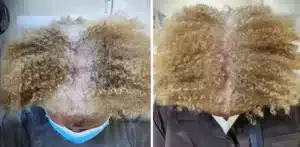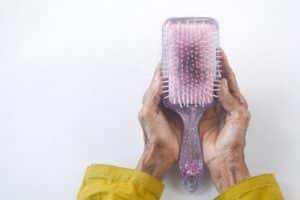Menopausal Hair Loss in Women – Causes, Symptoms & Treatment
1. What is Menopausal Hair Loss?
Menopausal hair loss is a common condition in women experiencing hormonal changes during perimenopause and menopause. It is characterized by thinning hair, increased shedding, and reduced hair volume, often resembling female pattern hair loss (androgenetic alopecia). While this type of hair loss is typically non-scarring, it can significantly impact self-confidence and quality of life.

2. Who is Most Commonly Affected?
- Women in their 40s, 50s, and beyond experiencing perimenopause or menopause.
- Those with a family history of hair thinning or androgenetic alopecia.
- Women undergoing hormonal treatments or significant stress.
3. What are the Symptoms?
- Gradual hair thinning, especially at the crown or part line of the scalp.
- More noticeable shedding when brushing, washing, or styling hair.
- Reduced hair volume and difficulty maintaining previous hairstyles.
- Wider part line or increased scalp visibility or bitemporal recession.
- Changes in hair texture, such as increased dryness or brittleness.
4. What Causes Menopausal Hair Loss?
- Hormonal Changes: A decline in estrogen and progesterone levels leads to slower hair growth and increased shedding.
- Increased Androgen Influence: Higher relative levels of androgens (male hormones) can contribute to miniaturization of hair follicles.
- Genetics: A hereditary predisposition to female pattern hair loss (androgenetic alopecia) plays a role.
- Nutritional Deficiencies: Low levels of iron, vitamin D, and biotin may contribute to hair loss.
- Stress & Lifestyle Factors: Chronic stress, poor diet, and lack of sleep can exacerbate hair thinning.
5. How is it Diagnosed?
- Clinical Examination: A dermatologist assesses hair density, scalp health, and pattern of hair loss.
- Blood Tests: Check for hormonal imbalances, thyroid dysfunction, iron deficiency, and other factors.
- Scalp Biopsy (if needed): Determines if hair follicle miniaturization or other underlying conditions are present.

6. What are the Treatment Options?
- Topical Treatments:
- Minoxidil (Rogaine) – FDA-approved for female pattern hair loss; stimulates hair growth.
- Oral Medications:
- Spironolactone – An anti-androgen that may help reduce hair thinning.
- Finasteride (off-label use in women) – May be prescribed in certain cases.
- Minodixil
- Hormone Replacement Therapy (HRT):
- Some women benefit from estrogen therapy, though it should be discussed with a doctor.
- Nutritional Support:
- Supplements like biotin, iron, vitamin D, and omega-3 fatty acids may help strengthen hair.
- Red Light or Low-Level Laser Therapy (LLLT):
- Devices like laser combs or caps can stimulate hair follicles.
- Platelet-Rich Plasma (PRP) Therapy:
- Involves injecting platelet-rich plasma into the scalp to promote hair growth.
- Hair Care & Lifestyle Changes:
- Avoid excessive heat styling, harsh chemicals, and tight hairstyles.
- Eat a balanced diet rich in protein, vitamins, and healthy fats to support hair health.
7. Can Menopausal Hair Loss Be Prevented?
- Early intervention with topical or oral treatments can slow progression.
- Maintaining a healthy lifestyle with a nutritious diet, regular exercise, and stress management can help support hair health.
- Routine dermatology check-ups can help monitor and manage hair changes.
8. Frequently Asked Questions (FAQs)
- Is menopausal hair loss reversible? While it can be managed, complete reversal depends on the cause and treatment effectiveness.
- How long does menopausal hair loss last? It varies; some experience temporary thinning, while others have progressive hair loss.
- Does hormone therapy help with hair loss? It may help in some cases, but results vary, and risks should be discussed with a doctor.
- Can natural remedies improve menopausal hair loss? A nutrient-rich diet, scalp massages, and herbal supplements may provide some benefits, but medical treatments are often more effective.
9. When to See a Dermatologist
If you notice persistent hair thinning, increased shedding, or scalp changes, consult a dermatologist for diagnosis and personalized treatment. Early management can help preserve hair density and improve scalp health. Don’t assume that because you are in menopause or perimenopause that that isthe cause of your hair loss. Women in that age group can experience other types of alopecia.
10. Next Steps & How to Get Treatment
If you suspect perimenopausal or menopausal hair loss, schedule an appointment with our hair loss dermatologist for a comprehensive evaluation. With the right treatment approach, hair loss can be managed, and overall hair health can be maintained.

